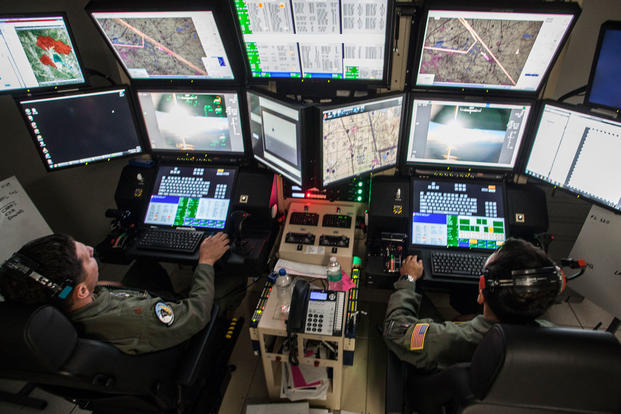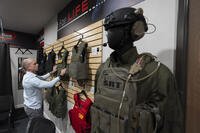MARCH AIR RESERVE BASE, Calif. -- Five years after a proof-of-concept mission to use the California Air National Guard's remotely piloted aircraft (RPA) in support of domestic wildland firefighting operations, the MQ-9 Reaper has developed into a key asset in California's fight against wildfires, including the Carr and Mendocino Complex Fires, which are currently burning in Northern California.
"It's a technology I never thought I'd see," said Jeremy Salizzoni, a fire technical specialist with the California Department of Forestry and Fire Protection (CAL FIRE) who embedded with the Cal Guard's 163d Attack Wing at March Air Reserve Base, California, during 2013's devastating Rim Fire.
More than a quarter of a million acres burned in August 2013 as the Rim Fire raged in Tuolumne County, California, to become the state's third largest wildfire on record, at the time. More than 100 structures were lost in the blaze, which took nine weeks to fully contain.
Eleven days after the Rim Fire started, the wing launched a first-of-its kind mission to overfly the fire with an MQ-1 Predator remotely piloted reconnaissance aircraft and beam back real-time video footage of the fire to Salizzoni and wing intelligence analysts working in an operations facility at March.
Through the Predator's footage, Salizzoni, who was used to driving for hours through rugged terrain to access overlook points and put eyes on the leading edge of a fire, could see any area of the fire he wanted, in real time and without ever leaving the operations facility.
The remotely piloted aircraft's thermal imaging camera provided a view of the fire unlike anything he'd ever seen. Traditional aerial assets are important, but encounter limitations due to smoke, fuel, altitude and field of view, he said.
"It was such a dramatic change from anything I'd seen in my career," Salizzoni said. "It was like being blind and then having vision in the blink of an eye."
Salizzoni and his colleagues knew they had a new tool in their firefighting toolbox.
"We saw things over the course of that fire that you couldn't have made up," he said. "I don't think there's a better intel resource at our disposal right now."
During its eight-day emergency activation for the Rim Fire, the 163d Reconnaissance Wing -- the unit's name at the time -- logged more than 150 hours of fire support and was credited with helping firefighters expedite containment.
In the five years since, the 163d has changed its name and the kind of airplane it flies, but one thing hasn't changed: the wing's dedication to domestic disaster response missions right here at home. The unit remains impassioned to innovate and provide first responders with instantaneous insight into what a fire is doing.
RPAs are no longer just trying to prove their worth, said U.S. Air Force Maj. Mike Baird, the senior intelligence officer at the 163d. The wing's MQ-9 Reaper RPAs -- a big-brother to the recently-retired Predators -- are an in-demand incident awareness and assessment asset preferred by California's civil authorities when disaster strikes.
The wing has supported more than 20 wildfires since 2013, but it takes more than just airplanes, Baird said. Keeping California safe takes a wing-wide effort.
"What we've been doing behind the scenes from maintenance and communications to refining our deployment and personnel processes has led up to our ability to provide an unprecedented level of MQ-9 support," Baird said.
The wing provided real-time full motion video support over a number of fires in 2017, including California's most destructive fire on record and also its largest fire to date. More than 5,600 structures were damaged and 22 lives were lost during the Tubbs Fire in Sonoma County in October. Two months later, in December, the Thomas Fire ravaged Ventura and Santa Barbara counties to become the state's largest fire on record with more than 280,000 acres burned.
As each fire rages, the wing works to refine its techniques and procedures, and works to expand the detailed real-time incident awareness and assessment data it provides to incident commanders. Innovation on the fly is the name of the game.
An investment by James G. Clark, Director of Air Force Innovation, and Col. Chris McDonald from Disruptive Innovation Division in Clark's office, helped the wing's Hap Arnold Innovation Center develop a specialized network to push and pull data from RPAs and other data-generating assets from civilian and military organizations.
The network's customizable data sets -- coupled with the RPAs' real-time thermal imagery -- provides incident commanders and first responders a common operating picture they can access from anywhere, anytime.
RPAs proved "an opportunity for people to make tactical and objective based decisions on real time information," Salizzoni said.
As the Rim Fire nears its fifth anniversary, RPAs are once again in the sky, flying through smoke, to deliver data and protect Californians as wildfires ravage the state.
By July 31, the 163rd was on its fifth fire of the summer.
Throughout July, the wing flew nearly 350 hours to support civil authorities working the County, Klamathon, Ferguson, Carr, Mendocino Complex, and Eel fires, and is credited with helping to protect thousands of structures in the process. The MQ-9 provided near real-time full motion video and frequent fire-line updates to decision makers determining where to build up future containment lines.
It's a marathon pace, but the wing's airmen up for it, said 1st Lt. Frank Cruz, officer in charge of the 163d Aircraft Maintenance Squadron, whose unit provides direct support for the MQ-9's around-the-clock fire operations to aid civil authorities.
"Everyone is 100% on board," Cruz said. "They're all-in."














